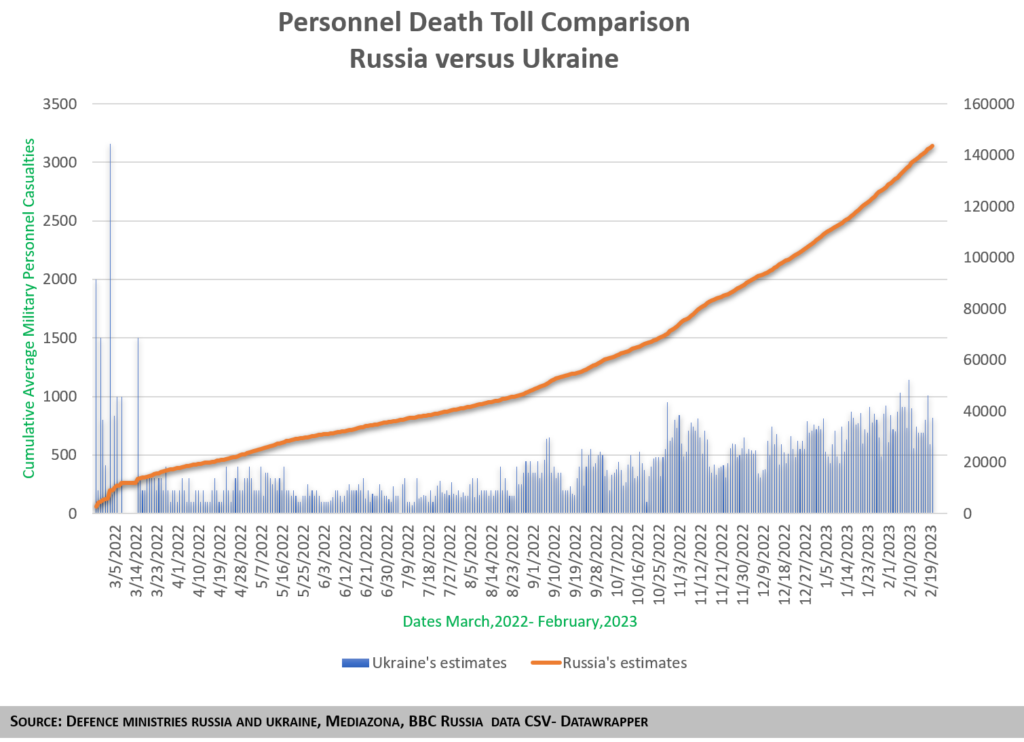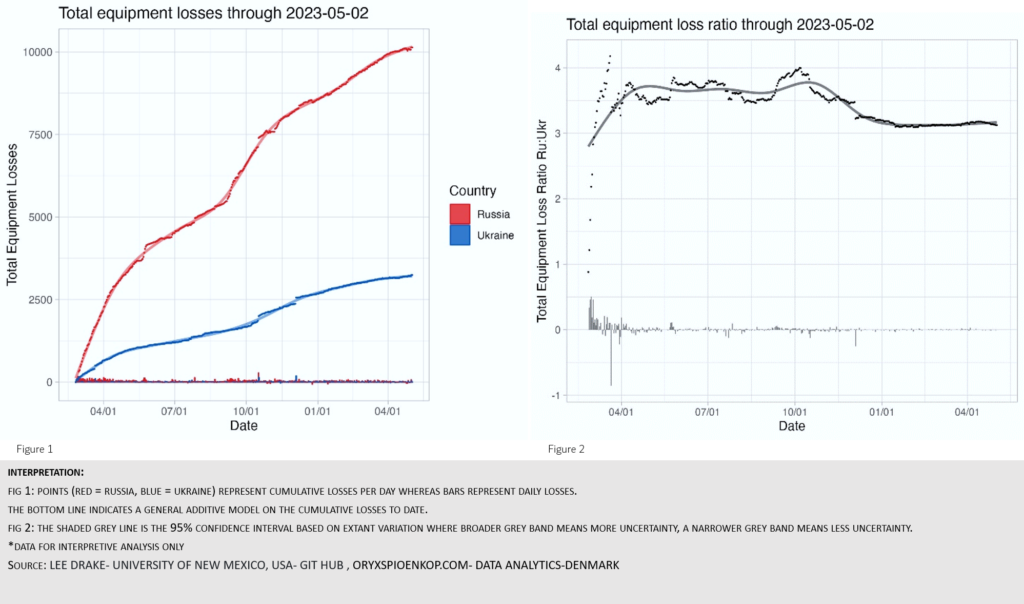“It is only one who is thoroughly acquainted with the evils of war that can thoroughly understand the profitable way of carrying it on”
Sun Tzu -The Art of War
Masters of Kievan Rus’?: Introduction
As the Russia-Ukraine war marks a year, it has been a long war and not a traditional warfare. The Russian military, which spends 11 times the defence budget of Ukraine, is also incurring combat losses at a staggering pace. Reports by the Russian Ministry of Defence claim personnel casualties of over 200,000, which is 125 percent more than in the two Chechen wars, which lasted 4 years, and 1300 percent more than the Soviet army lost during the 9 years of the war in Afghanistan.
Besides, Ukraine, despite having sixteen times fewer military capabilities than Russia, is neither visibly falling apart nor appears to be backing down.
Will this war have a victor? Steven Pifer, former US ambassador to Ukraine, assesses that “the war has taken a course of attrition, where Russia is trying to ensure an indecisive outcome.” Edward A. Kolodziej, author of The Limits of Soviet Power, supports the claim, suggesting that “at a mounting cost in blood and treasure, the balance of military forces between Ukraine and Russia in the coming year means neither side will break through against the other.” (Kolodziej, 2023). This article will, therefore, take stock of what is meant by attrition warfare and argue that actors engage in prolonged wars intending to end a conflict in a stalemate.
Attrition Warfare: My Way or the Highway
The Encyclopaedia of Military Science defines attrition war as “a style of warfare characterised by the effort to destroy an opponent’s ability or means to resist.” (Smith, 1974; Hendricks, Weiss, and Wilson, 1988). One of the earliest examples of attrition warfare is World War I, where the sole objective of the opponents was to sap resources and gain territory. Abel J. Esterhuyse argues in his seminal work, The Theories of Attrition versus Manoeuvre and the Levels of War, that “although campaigns were conducted in different parts of the world, the First World War was largely restricted to a relatively small geographical area in Western Europe… It was characterised by high personnel and equipment losses; the aim was to conquer terrain with no tactical or strategic value.“
Thus, a central feature of an attrition war is the exhaustion of valuable resources. Such a war is also known as Markov’s strategy by game theory proponents. The strategy is based on the concept of a zero-sum outcome, where opponents engage with maximum resources in the hope of maximising their advantages over time. The following are key objectives of an attrition war strategy:
- Heavy use of artillery: application of superior weapons and machinery is key, and the aggressor must be willing to pay the heavy cost in logistics or war casualties (Neillands, 2001).
- Hierarchical and centralised control: centralised combat hierarchy determines combat efficiency.
- Accept Casualties and Captured Territory: The primary battle metrics are damage to life and territory captured.
- Engagement: Prolonged conflict engagement can only inflict maximum damage on the opponent.
Imperial Gamble: Russia-Ukraine Attrition
Studies by scholars such as Ivan Arreguı´n-Toft, Matthew Wells, Allan C. Stam and Dan Reiter are the most representative of the current situation. They argue that time is a vital causal mechanism in an asymmetric warfare and casualties, and regime type impact the outcomes of a war.
An asymmetric conflict is a cross-border military unrest involving actors with significant disparity in military and material prowess. (Toft, 2005) and adherence to demands remains the sole objective of the stronger actor and not complete destruction of the opponent. This is believed to be viable only if prolonged violent engagement continues.
However, prolonging the duration is also advantageous for the weaker actor lending them opportunities of acquiring external economic support for sustaining the violent attacks. A weaker nation according to Toft is more survival driven and indulges their opponent’s will to prolong war while capturing or claiming territory, and infrastructural resources, altering the nature of war into attrition. (Toft, 2007). Supporting the argument, The Institute for the Study of War – Washington reportedly projected territorial re-gains by Ukraine within months.

In the same vein, Mathew Wells, in his study on casualties, regime type, and the outcomes of wars of occupation, asserts that the nature of regime types is also a decisive factor in the outcome of a war. He considers Russia a capitalist-autocracy (a mixed regime, neither highly repressive nor democratic) and Ukraine a presidential democracy to suggest that even though control over the duration of war resides with the strong actor (Fearon 2007; Powell 2004; Slantchev 2003b; Smith and Stam 2004; Wagner 2000), there exists a negative correlation between variables of war causality, i.e., the probabilities of outcomes and the duration of war for democracies. In contrast, autocratic and mixed regimes are more willing to accept higher casualties and combat losses before withdrawing from the battlefield. (Wells, 2016).


Situationship: Games and Outcomes
Gernot Erler, a former member of the German Bundestag, terms Russia-Ukraine aggression “the principle of organised unpredictability.” On May 9, 2023, Russia hosted leaders from Central Asia for its annual Victory Day parade while simultaneously also retreating due to Ukrainian attritional assaults in the eastern Ukrainian city of Bakhmut. Ukraine, too, lost its Chief Advisor to the Directorate for Domestic and Humanitarian Policy, Alexei Titarenko, in the missile duel. Attrition warfare, thus, is more of a belief system than a strategic system. (Langlois and Langlois, 2006; Harsanyi, 1973). These series of polarities show how the actors overestimate their gains against the pressure of losses without offering or bargaining for any concessions.
Especially the stronger actor, who aims to accept losses if the stakes are high for the opponent and it becomes arduous to disengage with the goal of preserving the status quo antebellum, creating a deadlock. Alongside, a weaker actor also does the same until they can arrive at a position of offering a minor concession to their stronger opponent. A concession that the stronger could have guaranteed themselves had they acted rationally.
Thus, both sides reach a strategic stalemate because losses are justified as a means to an end. These motives of attrition warfare thus imply that players in a contest make choices with probabilities, and as time passes, neither side will enjoy concessions over and above their best alternatives to a pre-existing negotiated agreement.
Conclusion: Men are mortals, and so are ideas
“No war is so sanguinary as the war of exhaustion. No plan could be more unpromising than the plan of a frontal attack. Yet on these two brutal expedients, the military authorities of France and Britain consumed the flower of their national manhood.”
-Winston Churchill
This famous quote by Winston Churchill on the aftermath of World War I encapsulates the present situation at the fronts of the Russia-Ukraine war. While states at war continue to delay negotiations in the hope that the opponent will give in, studies show a negative outlook on the successful outcomes of prolonged attrition warfare. As much as military capabilities or combat losses play a decisive role during the course of a war, both Russia and Ukraine have also shown that military might and willingness to commit resources to the war effort are in equilibrium, and it is not always the strong that wins.
While beliefs take precedence over strategic values in attrition warfare, it is the duration of the war that becomes the final battlefield metric, eventually rendering it an impasse.
References:
- America’s National Churchill Museum. (n.d.). Winston Churchill Biography. www.nationalchurchillmuseum.org. Retrieved May 12, 2023, from https://www.nationalchurchillmuseum.org/churchill-in-world-war-i-and-aftermath.html
- Arreguín-Toft, I. (2005, December 8). How the Weak Win Wars. International Security, 26(No. 1 (Summer 2001)), 93–128. https://doi.org/10.1017/cbo9780511521645
- Attrition Warfare: When Even Winners Lose. (2023, May). Farnam Street. Retrieved May 12, 2023, from https://fs.blog/attrition-warfare/
- Filson, D., & Werner, S. (2004). Bargaining and Fighting: The Impact of Regime Type on War Onset, Duration, and Outcomes. American Journal of Political Science, 48(2), 307–311. https://doi.org/10.2307/1519884
- Institute for the Study of War. (n.d.). Institute for the Study of War. http://dev-isw.bivings.com/
- L. (n.d.). GitHub – leedrake5/Russia-Ukraine: Equipment Loss Tracking. GitHub. https://github.com/leedrake5/Russia-Ukraine
- Kolodzie. (2023, March 21). Is Russia-Ukraine war heading toward stalemate? College of Liberal Arts & Sciences | Illinois Global Institute Center for Global Studies. Retrieved May 12, 2023, from https://cgs.illinois.edu/news/2023-03-21/russia-ukraine-war-heading-toward-stalemate
- Langlois, C. C., & Langlois, J.-P. P. (2009). Does Attrition Behavior Help Explain the Duration of Interstate Wars? A Game Theoretic and Empirical Analysis. International Studies Quarterly, 53(4), 1051–1073. doi:10.1111/j.1468-2478.2009.00568.x
- Moore, Matthew (2012). Selling to Both Sides: The Effects of Major Conventional Weapons Transfers on Civil War Severity and Duration. International Interactions 38(3), 325–347.
- Nakao, K. (2022, April 23). Democratic Victory and War Duration: Why Are Democracies Less Likely to Win Long Wars? SSRN Electronic Journal, 6–38. https://doi.org/10.2139/ssrn.4091692
- Petro Ivaniuk. (2022). <i>2022 Ukraine Russia War</i> [Data set]. Kaggle. https://doi.org/10.34740/KAGGLE/DS/1967621
- Piehler, K. G. (2013, November 8). Sage Reference – Encyclopedia of Military Science. Sage Reference – Encyclopedia of Military Science, 191-192. https://doi.org/10.4135/9781452276335
- Putin’s Reach: Merkel Concerned about Russian Influence in the Balkans,” Spiegel Online International, November 17, 2014 (www.spiegel.de/international/europe/germany-worried-about-russian-influence-in-the-balkans-a-1003427.html).
- Reiter, D., & Stam III, A. C. (1998). Democracy and battlefield military effectiveness. Journal of Conflict Resolution, 42(3), 259-277.
- Wells, M. (2016). Casualties, regime type and the outcomes of wars of occupation. Conflict Management and Peace Science, 33(5), 469–490. https://www.jstor.org/stable/26271439
